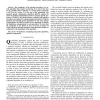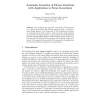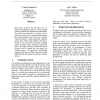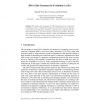NN
2000
Springer
15 years 12 days ago
2000
Springer
We address two issues in Evolutionary Robotics, namely the genetic encoding and the performance criterion, also known as fitness function. For the first aspect, we suggest to enco...
103
Voted
TEC
2008
15 years 15 days ago
2008
Abstract--The complexity of the selection procedure of a genetic algorithm that requires reordering, if we restrict the class of the possible fitness functions to varying fitness f...
99
Voted
IJIT
2004
15 years 2 months ago
2004
In this contribution, the use of a new genetic operator is proposed. The main advantage of using this operator is that it is able to assist the evolution procedure to converge fast...
91
Voted
EVOW
2008
Springer
15 years 2 months ago
2008
Springer
We investigate the automatic construction of visual scenes via a hybrid evolutionary/hill-climbing approach using a correlationbased fitness function. This forms part of The Painti...
125
click to vote
FLAIRS
2008
15 years 2 months ago
2008
Rule extraction is a technique aimed at transforming highly accurate opaque models like neural networks into comprehensible models without losing accuracy. G-REX is a rule extract...
94
Voted
GECCO
2006
Springer
15 years 4 months ago
2006
Springer
We show that there are unimodal fitness functions and genetic algorithm (GA) parameter settings where the GA, when initialized with a random population, will not move close to the...
105
Voted
ICRA
1998
IEEE
15 years 4 months ago
1998
IEEE
This paper describes the innovative use of a genetic algorithm to solve the grasp synthesis problem for multifingered robot hands. The goal of our algorithm is to select a `best&#...
121
Voted
GECCO
1999
Springer
15 years 4 months ago
1999
Springer
This paper describes the innovative use of genetic programming (GP) to solve the grasp synthesis problem for multifingered robot hands. The goal of our algorithm is to select a Ò...
GECCO
2003
Springer
15 years 5 months ago
2003
Springer
We explore the advantages of DNA-like genomes for evolutionary computation in silico. Coupled with simulations of chemical reactions, these genomes offer greater efficiency, reliab...




